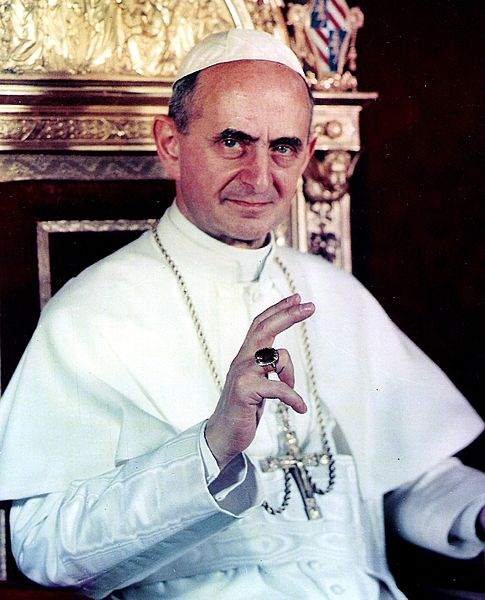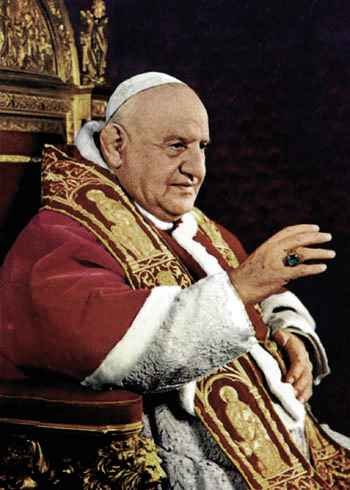Last week I met briefly with Father Joe for my first RCIA interview. The biggest question I’ve been having, I told him, was about the Second Vatican Council. I posted about these thoughts recently. Tonight at RCIA, as if in answer to my prayers, we had a guest speaker, Father Scott, who spoke at length on Vatican II. He answered my every concern. Between Father Scott and Father Joe, I received what I was hoping for: a firm position, from the inside, on how, as conservative, traditional, orthodox Catholics, to view and understand Vatican II.
Father Scott is a young priest who received his vocation while a member of Father Joe’s flock. He appeared wearing a black cassock — a symbol and reminder, he said, that the priesthood and his vows are something not of this world. “The call from God — you can’t really get away from it,” he began. He addressed Vatican II in its context, as the first ecumenical council called in a century, the first since the abortive Vatican I, which had been interrupted by war and the occupation of Rome before it could address the issues of modernity it hoped to address, the great issues of the nineteenth century: liberalism, nationalism, rationalism, humanism, and Darwinism. Papal infallibility was the only doctrine it had been able to promulgate, reasserting the Church’s authority in the face of so many challenges. Eighty years later, after so many more challenges — after two world wars, and so much global devastation and anguish and disillusionment — Pope John XXIII, who was supposed, at his election (after twenty-five votes), to be only a short-lived, transitional, stopgap pope, called the Second Vatican Council within the first three months of his papacy. According to popular myth, Pope John is supposed to have said that he wanted to “throw open the windows” of the Vatican “to let in fresh air” — or, as Father Joe interjected, to let the world back into the Church. (Apparently, Pope John is unlikely to have said anything of the sort — coming from good, peasant stock, he understood the dangers of letting in drafts.)
According to Father Scott, Pope John had three reasons for calling the council:
- To bring about the spiritual renewal of the Church.
- To update pastoral practices for dealing with the modern world.
- To promote a restoration of unity among all Christians.
In the first document Pope John issued as pope, in fact (I’m going to guess the encyclical Ad Petri cathedram), he was the first pope to directly address Protestants.

Pope Paul VI, who re-called the Second Vatican Council following the death of Pope John XXIII in 1963.
Father Scott then led us through the highlights of the Vatican II documents — the key to understanding what the council actually said. So many, at the time of the council and especially since, have gotten the idea that the Church was changing — “but they’re just reading the headlines, not the documents,” he said. Father Scott demonstrated that the word of the documents demonstrates nothing but continuity with the 2,000 years of Catholic tradition. The documents cite, at every turn, the Council of Trent, the Church Fathers, and everything in between. The Vatican II Council Fathers were renewing the Church, not creating a new one.
He addressed the divide in the interpretation of the council, from ultraconservative Traditionalists, who were so convinced of the council’s rupture with tradition that they broke away to form the Society of St. Pius X, to liberals, who, reading only the “headlines,” seized upon the “spirit of Vatican II” to proclaim things that the documents didn’t actually say, such that Latin was no longer the language of the Church or that the Church hierarchy was no longer in place — but the council documents in fact affirm these things. Their liberal, modernizing vision for the Church was to move her away from Christ’s mission of salvation and justification, and towards social reform — not to transform the world to more closely adhere to Christ, but to transform the Church to more closely fit the modern world.
In particular, as I was concerned, and as many others have been concerned, the constitution Sacrosanctum Consilum, the first constitution issued by the council, addressed the reform of the liturgy. It reaffirmed that the Eucharist is the source and summit of our faith, that it needs to be understood and celebrated by all, and that all should participate actively. There has been much contention about the definition of that “active participation” — but nothing in the council documents eradicated Latin as the liturgical language, or even insisted on a versus populum orientation in the Mass. Versus populum was an “experiment” after the fact of the council, one that was deemed to be “pastorally advantageous,” and suggested “for the good of the people.”
As far as revising the liturgy, the intent of the Council Fathers was to eliminate repetition and redundancy that had grown in the Mass, and to bring back meaningful prayers and lay participation that had fallen out of use over the centuries. Every effort was made that nothing was invented, and nothing was lost — that the revisions brought about only renewal. The promulgation of the revisions was overly hasty, however — the new Roman Missal in 1970, and an English translation only three years later. In this rush, the text lost much clarity and unity, approximating only the “gist” of the Latin Mass. The new English translation, in being a more faithful rendering of the Latin, aims to recover what was lost.
Father Joe ascribes particular blame for this rush, for this getting carried away, for this tendency to read “headlines” and not the words of the documents themselves, to the rise of great publishing companies in the 60s, who seized upon the opportunity of Vatican II to capitalize on a myriad of books, pamphlets, tapes, workshops, and endless other products to help Catholics, priests and laypeople alike, understand the changes of the council — only they spread much misinformation, misunderstanding, and wrongheadedness, in the “spirit of Vatican II” — and many Catholics who have grown up in the post-Vatican II era have never recovered.
It was a great council; it just came at the worst possible time — in the heat of the Civil Rights Movement and the Sexual Revolution and the Vietnam War and worldwide social upheaval of every kind. In the face of such upheaval, the world needed the reassuring voice of the Mother Church more than ever; and the Second Vatican Council meant to offer that voice. The documents themselves speak to such reassurance for the modern world; but in the momentum of so much other reform, activists seized upon “sound bites” and “headlines” of the council to take the Church in directions the Council Fathers never intended. “The Council Fathers wanted to welcome the modern world,” Father Scott summed up, “but they were not modernizing the Church so much as they were working to sanctify the world — to bring the world into the Church.”
It is indeed an exciting time to be entering the Church. “The Church is always correcting herself; always reforming herself.” Vatican II was not in itself a rupture — there is no rupture in the 2,000 years of Church tradition — but the Church is now, as only now we begin to understand the Second Vatican Council, moving to correct the mistakes that have been made in the council’s wake.



